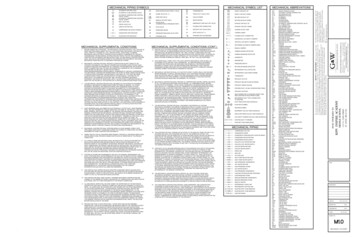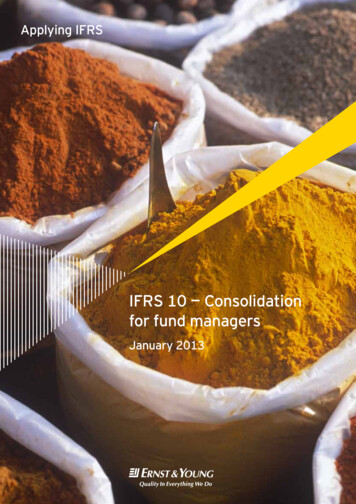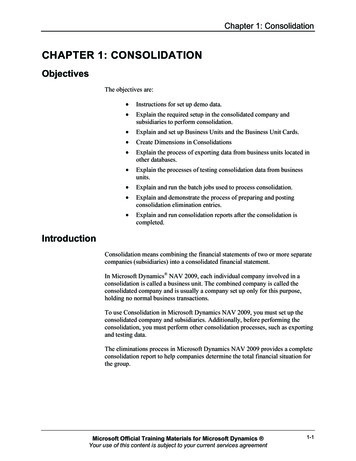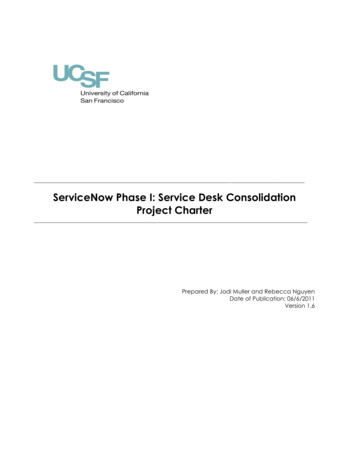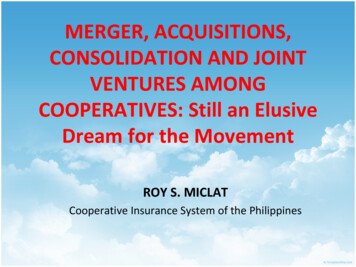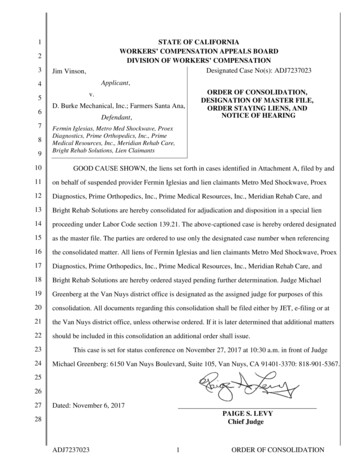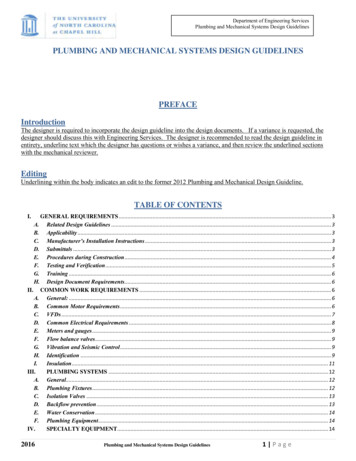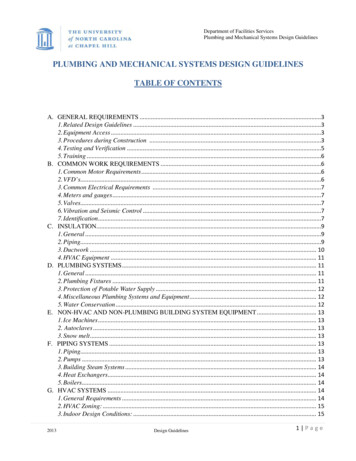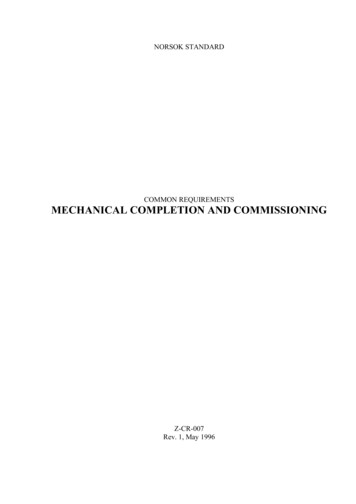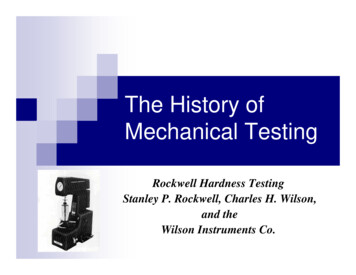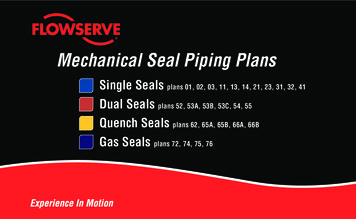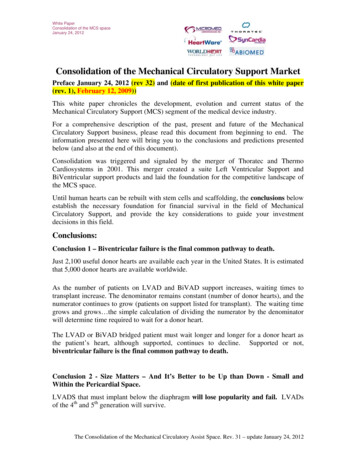
Transcription
White PaperConsolidation of the MCS spaceJanuary 24, 2012Consolidation of the Mechanical Circulatory Support MarketPreface January 24, 2012 (rev 32) and (date of first publication of this white paper(rev. 1), February 12, 2009))This white paper chronicles the development, evolution and current status of theMechanical Circulatory Support (MCS) segment of the medical device industry.For a comprehensive description of the past, present and future of the MechanicalCirculatory Support business, please read this document from beginning to end. Theinformation presented here will bring you to the conclusions and predictions presentedbelow (and also at the end of this document).Consolidation was triggered and signaled by the merger of Thoratec and ThermoCardiosystems in 2001. This merger created a suite Left Ventricular Support andBiVentricular support products and laid the foundation for the competitive landscape ofthe MCS space.Until human hearts can be rebuilt with stem cells and scaffolding, the conclusions belowestablish the necessary foundation for financial survival in the field of MechanicalCirculatory Support, and provide the key considerations to guide your investmentdecisions in this field.Conclusions:Conclusion 1 – Biventricular failure is the final common pathway to death.Just 2,100 useful donor hearts are available each year in the United States. It is estimatedthat 5,000 donor hearts are available worldwide.As the number of patients on LVAD and BiVAD support increases, waiting times totransplant increase. The denominator remains constant (number of donor hearts), and thenumerator continues to grow (patients on support listed for transplant). The waiting timegrows and grows the simple calculation of dividing the numerator by the denominatorwill determine time required to wait for a donor heart.The LVAD or BiVAD bridged patient must wait longer and longer for a donor heart asthe patient’s heart, although supported, continues to decline. Supported or not,biventricular failure is the final common pathway to death.Conclusion 2 - Size Matters – And It’s Better to be Up than Down - Small andWithin the Pericardial Space.LVADS that must implant below the diaphragm will lose popularity and fail. LVADsof the 4th and 5th generation will survive.The Consolidation of the Mechanical Circulatory Assist Space. Rev. 31 – update January 24, 2012
The detail of each LVAD reveals that five functional generations of LVADS exist:1.2.3.4.5.Original large and cumbersome devices, such as the HeartMate I andNovacorAxial flow pumps, such as the Thoratec HeartMate II and the Berlin HeartINCOR – smaller devices, yet requiring a pocket below the diaphragm andplumbing to the pericardial spaceCentrifugal pumps, such as the DuraHeart, or the VentrAssist, areimplanted below the diaphragm in a pocket and plumbed through thediaphragm into the pericardial spaceAxial flow or centrifugal flow pumps, such as the HeartAssist5 byMicroMed and the HVAD by HeartWare, implanted within the pericardialspaceAxial flow or centrifugal flow pumps with accurate flow measurement andimplanted within the pericardial space, such as the HeartAssist 5 (the onlyproduct that meets the test for level 5)Predictions for 2012 - 20141. Thoratec may be purchased by a “Large Med Tech” company that will “buy” itsway into a proven and large market .however if that occurs, the purchaser willbe burdened with the challenge of upgrading to a device that implants within thepericardial space. The HeartMate II is too large and a new pump must bedesigned, tested and studied to gain approval.2. SynCardia may be purchased by a company interested in entering the mechanicalcirculatory support market or it may be purchased by a company in the MCSspace.3. HeartWare may be acquired or they may use their public currency to build a suiteof products that broaden their competitive reach,4. All but one of LVADs that implant below the diaphragm will be discontinued5. The potential combination of SynCardia and an above the diaphragm LVAD(MicroMed or HeartWare (pericardial space LVAD)) could an ideal combinationof products for the Transplant Center OR suite.6. The TAH will become more common and be accepted similar to the acceptance ofventilator, portable oxygen or artificial knee or hip – a prosthesis. Biventricularfailure is the final common pathway to death and can be treated with a prosthesis.Alert: MicroMed may have the TAH of the future.7. All four companies are guided by capable CEOs:Thoratec - Gerhard (Gary) Burbach joined Thoratec as president and chief executiveofficer in January 2006, at which time he was appointed to the board of directors. Prior tohis arrival, Burbach served as president and chief executive officer of DigiradCorporation, a leading provider in solid-stage cardiology and nuclear medicine imaging2
products and services, and continues to serve on the board of directors. Burbach has heldexecutive positions at Bacchus Vascular Inc. and Philips Nuclear Medicine, as well as theconsulting firm of McKinsey & Company, Inc. He has a bachelor's degree in industrialengineering from Stanford University and a master's degree in business administrationfrom Harvard Business School.HeartWare - Doug Godshall, age 46, has been the Chief Executive Officer of HeartWareLimited and subsequently HeartWare International, Inc., since September 2006 andbecame a director of HeartWare Limited and subsequently HeartWare International, Inc.,in October 2006.Prior to joining HeartWare Limited, Mr. Godshall served in various executive andmanagerial positions at Boston Scientific Corporation, where he had been employed since1990, including as a member of Boston Scientific?s Operating Committee and sinceJanuary 2005, as President, Vascular Surgery. Prior thereto, Mr. Godshall spent fiveyears as Vice President, Business Development, at Boston Scientific, where he wasfocused on acquisition strategies for the cardiology, electrophysiology, neuroradiologyand vascular surgery divisions.Mr. Godshall has a Bachelor of Arts in Business from Lafayette College and Masters ofBusiness Administration from Northeastern University in Boston, MassachusettsSynCardia – Michael Garippa, age 57, CEO of SynCardia Systems Inc.Michael Garippa is the former CEO and President of TandemHeart. He was recruited byTandemHeart in 2002 as a turnaround expert and stayed on as CEO and President. Heprogressed TandemHeart from an R&D firm that had lost an aggregate of 50 million andhad no commercial sales to a successful company with over 6 million in net income in2010.Prior to joining TandemHeart, Mr. Garippa served as CEO and President of GatewayHome Care. In addition, Mr. Garippa was Founder and CEO of Millennium HomeCareand The Prompt Care Companies. His background also includes being National SalesManager at Omni Medical and Senior Analyst with the NYC Health and HospitalsCorporation. Mr. Garippa holds a B.A. degree from Rutgers University and a master'sdegree from New York University.MicroMed - David Mackstaller, age 69, CEO of MicroMed Cardiovascular. Mr.Mackstaller holds a B.A. degree in Economics from the University of Michigan and aJuris Doctorate, Cum Laude, from the University of Michigan Law School. He practicedlaw with a Detroit Law firm from 1968 to 1970, there specializing in real estate law, withparticular emphasis on partnerships, corporations, and taxation.From 1984 until 1991, J. David Mackstaller was the Executive Vice President and a 50%owner of the Schomac Group, Inc., and National Self Storage Management, Inc. He wasa co-founder of both companies. Mr. Mackstaller was co-founder of Anthem EquityGroup, Tucson Arizona in 1991.3
Mr. Mackstaller is the Vice President of Business Development at SynCardia Systems.There he and his longtime partner Mr. Ford raised the capital which funded SynCardiaduring its development and launch of the Freedom portable driver, the world’s firstwearable power supply for the Total Artificial Heart.Mr. Mackstaller co-led the acquisition of MicroMed Cardiovascular in 2008. MicroMedwas a public company acquired by E-Wilson LLC, a group formed for the purpose ofacquiring the outstanding public sharesConsolidation of the Mechanical Circulatory Support MarketI.SynCardia Formation and Historical OverviewSynCardia Systems, Inc. was formed in August of 2001 by Marvin J. Slepian, MD, JackCopeland, MD, and Richard Smith, MSEE, CCE, who were then and are now employedby the University Medical Center (UMC), Tucson, Arizona.Robert Sarver, a successful businessman and native of Tucson, provided SynCardia’sinitial capital and an “A” round of 2.7M in September of 2002. Sarver had previouslyfunded the Sarver Heart Center at UMC, where Dr. Copeland had treated his father, Jack,for heart disease.SynCardia was formed to commercialize the CardioWest Total Artificial Heart (TAH)and began by purchasing the TAH technology from UMC’s subsidiary, CardioWest. Theassets acquired by SynCardia included:1.A high tech manufacturing facility located in Tucson, AZ 85713;2.Know-how to manufacture the 70cc TAH and drive the TAH.3.Manufacturing equipment;4.All the design records and experience from the preceding owners, i.e.,CardioWest preceded by Symbion (Jarvik); and5.A small core team of individuals who had been with the project for asubstantial amount of time, including some employees from the Symbionera.Almost 10 years prior to SynCardia’s purchase of these assets, UMC had purchased thecardiac support business of the Symbion total artificial heart from Symbion, Inc.,following its liquidation in 1991. By 2007 in excess of 200MM had been invested in theproject.From 2004 to 2005, SynCardia raised an additional 20.5M through a “B” round offinancing, and many new SynCardia investors joined the original group.Rodger Ford, an “A”, “B”, and as of December of 2010 a “C”, “D” and “E”) roundinvestor, was appointed to the Board of Directors of SynCardia in late 2002. In October4
of 2004, SynCardia received PMA approval from the FDA for the CardioWest TAH.The company received full CE (European) approval for the TAH in 2005.Before deciding to invest in SynCardia, most individuals concluded that there were a fewkey elements that made SynCardia an exceptional opportunity. These included:1.No CompetitionSynCardia and the CardioWest TAH had no competitors. While several companies wereattempting to develop technology to assist a sick and weakening heart (Ventricular AssistDevice – VAD), no other company had a workable means of replacing a failed humanheart (Biventricular Replacement) with a mechanical heart.A few companies tried to address this need, but none of them became commerciallysuccessful.The AbioCor fully Implantable Replacement Heart, manufactured andmarketed by Abiomed, initially appeared to show promise, but has been shelved becauseof technological and cost limitations. The AbioCor weighs 2.5 pounds and as ofNovember of 2011, has been implanted in only 15 patients, with results that did notwarrant any further use of the device. At one FDA hearing for the AbioCor it was saidthat “ It was unclear if the AbioCor prolonged life or prolonged death.”SynCardia remains one of a kind, and by the spring of 2003, over 500 patients hadreceived a CardioWest TAH, and the gift of life. By the end of 2011 the patient countbenefiting from SynCardia TAH will exceed 1,0002.FDA ApprovalWhile FDA PMA approval for the CardioWest TAH was not certain, the SynCardiafounders believed it to be very likely. At that time, the CardioWest TAH had alreadybeen implanted successfully as a bridge to transplant in more than 500 patients since1988. The bridge to transplant success rate of 79% for the CardioWest was twice the rateof the most effective alternative therapy (Thoratec biventricular support system).3.A Solid History of Research and Development of the TAHIt had been estimated by SynCardia management that since the early eighties more than 200MM had been invested in furthering the development of the TAH, originally knownas the Jarvik 100. The major development efforts that provided the foundation forSynCardia were:a.Willem Kolff Design (b. 1912 – d. February 12, 2009)The inventor of the Jarvik TAH, Kolff began his work on the ArtificialHeart in 1948 and gave credit to all who supported him in his work,including Dr. Robert Jarvik at the University of Utah in 1978.http://en.wikipedia.org/wiki/Willem Johan Kolffb.Symbion Development5
A public company formed to further develop and market the Kolff TAH,which became the Jarvik-7.c.University Medical Center Clinical LeadershipUMC and its investment in the CardioWest TAH, previously the Jarvik100 and the Jarvik tory.php4.Historical Proxies for SynCardia’s Value (2004 proxies)Because SynCardia is a private company, its value is not reflected on any exchange or byany direct means. Therefore, in 2003/2004, the best bellwethers or proxies forSynCardia’s value were the few public companies that occupy the “MechanicalCirculatory Support” sector of the medical device industry.a.b.c.Thoratec – Market Cap - 600MM – Mechanical Circulatory Supporti.HeartMate I – implantable, electrically powered, continuous flowLVAD weighing over 1100 grams.ii.iVAD and pVAD – pneumatic, pulsatile biventricular supportsystems.iii.Thoratec had received approval from the FDA to dischargepatients to home with a mobile pneumatic driver that powered theirbiventricular support systems.iv.Thoratec had received PMA approval from the FDA for theirpneumatic pulsatile BiVADs and the electrically poweredcontinuous flow HeartMate II LVAD.Abiomed – Market Cap - 300MM – Mechanical Circulatory Supporti.Pneumatic pulsatile BVS and AB 5000 BiVAD system.ii.AbioCor Implantable Replacement Heart. To date, the electricallypowered pulsatile AbioCor has been implanted only 14 times, thelast one in 2004.World Heart – Market Cap - 400MM – Mechanical Circulatory Supporti.d.Novacor – electrically powered, pulsatile, implantable LVADpurchased from Edwards Life Sciences. Very large, weighing over1400 grams.Arrow International - Market Cap - 1.6B – Tube Set and Balloon Pumpsi.LionHeart - electrically powered, pulsatile.ii.CorAide - electrically powered, continuous flow.6
iii.e.Terumo – Market Cap – 6.2B – Catheter and tube setsi.f.g.h.i.INCOR electrically powered, continuous flow LVAD, justbeginning to be distributed, CE marked and surprisingly similar tothe MicroMed DeBakey LVAD, although 3x larger.ii.Biventricular pneumatic pulsatile support, powered by the IKUSand EXCOR drivers.MEDOS GmbH - Private – Mechanical Circulatory Supporti.Heimes pneumatic pulsatile drive system.ii.6 sizes of extracorporeal pneumatic pulsatile biventricular pumps.Ventracor (Aus) – Market Cap - 500MM (AUS )– MechanicalCirculatory SupportDataScope – pneumatic pulsatile balloon pump.MicroMed – private - Mechanical Circulatory Supporti.II.LVAD-pulsatile – odd device that surrounds the aorta and behavesmore like an outside-in balloon pump.DataScope - Market Cap - 500MM – Mechanical Circulatory Supporti.l.MVAD – LVAD.Sunshine Heart (Aus) - Market Cap - 16MM (AUS ) – MechanicalCirculatory Supporti.k.VentrAssist electrically powered, continuous flow LVAS.HeartWare (Aus) - Market Cap - 100MM (AUS ) – MechanicalCirculatory Supporti.j.DuraHeart - electrically powered, continuous flow – one of manyproducts, CE approvals and little penetration. Only 25 implants asof 2003.Berlin Heart GmbH – Private – Mechanical Circulatory Supporti.i.Arrow pulsatile balloon pump – sales of 65MM.DeBakey electrically powered continuous flow LVAD.MilestonesMany “B” round investors joined SynCardia as it was being transformed from a scienceproject to an operating and the promise of a profitable company (not a small task). It was7
clear that there were only three major milestones to creating value for SynCardia, andworldwide deployment of the CardioWest TAH would follow.A.The Steps1.ApprovalFDA approval of the CardioWest TAH.2.DriversAlternative driver technology to replace the limited number of “Big Blue”TAH pneumatic drivers. Only 36 drivers existed in the SynCardia fleet asartifacts from Symbion. This limited number of drivers constrained thenumber of patients SynCardia could help and the number of TAHsSynCardia could sell.The driver technology was obsolete, more drivers could not bemanufactured, and alternative drivers had to be sourced or designed andmanufactured. A contract for an alternative driver had been entered intobetween SynCardia and MEDOS of Germany in early 2003 for themodification of the Heimes HD8 biventricular support driver, which wasused at that time to drive the MEDOS pneumatic pulsatile BiVADs.3.ReimbursementCMS, Medicare and Medicaid reimbursement (a source of payment) toencourage private insurance companies to follow with a paymentschedule. CMS was reimbursing BiVADs and LVADS, but not theArtificial Heart.B.The Outcome1.ApprovalFDA granted the CardioWest TAH a full PMA approval on October 15,2004. This signal event would normally have been the inflection point toignite availability of the SynCardia CardioWest TAH worldwide. This didnot happen because the world distribution opportunity and value ofSynCardia was suppressed by the two remaining milestones.2.DriversMEDOS had made no progress on converting the Heimes HD8 driver todrive the CardioWest TAH. The project was terminated in the earlyspring of 2006.However, promising news had surfaced from the collaboration of BerlinHeart GmbH and the Heart and Diabetes Center NRW in Bad8
Oeynhausen, Germany.A “skunk works” thrust forward by thedetermination of Aly El Banayosy, MD, converted the Berlin HeartEXCOR pneumatic pulsatile BiVAD driver to power the CardioWestTAH. Stable TAH patients supported by the “Big Blue” drivers weretransferred to EXCOR TAH drivers and were discharged from the hospitalto recover at home while awaiting a donor heart.Dr. Banayosy’s work proved that stable TAH patients would recover andthrive out of the hospital. The EXCOR driver was only suitable for stableTAH patients and it did not have the range of adjustment or power tosatisfy the requirements of the Operating Room or Intensive Care Unit.3.ReimbursementBy 2005, SynCardia management began working to overturn the CMSNon-Coverage Decision that excluded reimbursement for the TAH, whileallowing reimbursement for BiVADs and LVADs.The non-coverage decision was astonishing, considering the bridge totransplant record of the CardioWest TAH relative to LVADS andBiVADs. The non-coverage decision had not previously been challengedbecause there was no FDA approved artificial heart that would requirereimbursement.Thus, in November of 2004, it was very clear that, for SynCardia to launch a successfulIPO or engineer a sale to an eager buyer,III. alternative drive systems would be needed to support the TAH; Medicare (“CMS”) reimbursement would be required to stimulate the use of theTAH, and additional effort would be necessary to prepare SynCardia to succeed, as thecompany had to become an efficient and systemized operating unit to leveragehuman capital. Sales must demonstrate velocity, volume and pricing powerMay 2005 to May of 2011David Mackstaller and Rodger Ford joined SynCardia full time in March of 2005: Davidas VP – Development, and Rodger as CEO. They set out to install reliable businesssystems to leverage human capital and complete the three remaining hurdles:1. Reimbursement from CMS; and2. Replacement drivers and evolution of the TAH3. Generate sales9
October 2008 marked a significant milestone in the maturity of the SynCardia and theCardioWest TAH. The Centers for Medicare and Medicaid (CMS) granted a record levelof reimbursement to the SynCardia TAH and declared, “The TAH fills a role that noother mechanical circulatory support device can for patients in irreversible biventricularfailure.”Reimbursement in the amount of DRG 1 (up to 292,000) was available, plus a newtechnology add
Juris Doctorate, Cum Laude, from the University of Michigan Law School. He practiced law with a Detroit Law firm from 1968 to 1970, there specializing in real estate law, with particular emphasis on partnerships, corporations, and taxation. From 1984 until 1991, J. Dav
